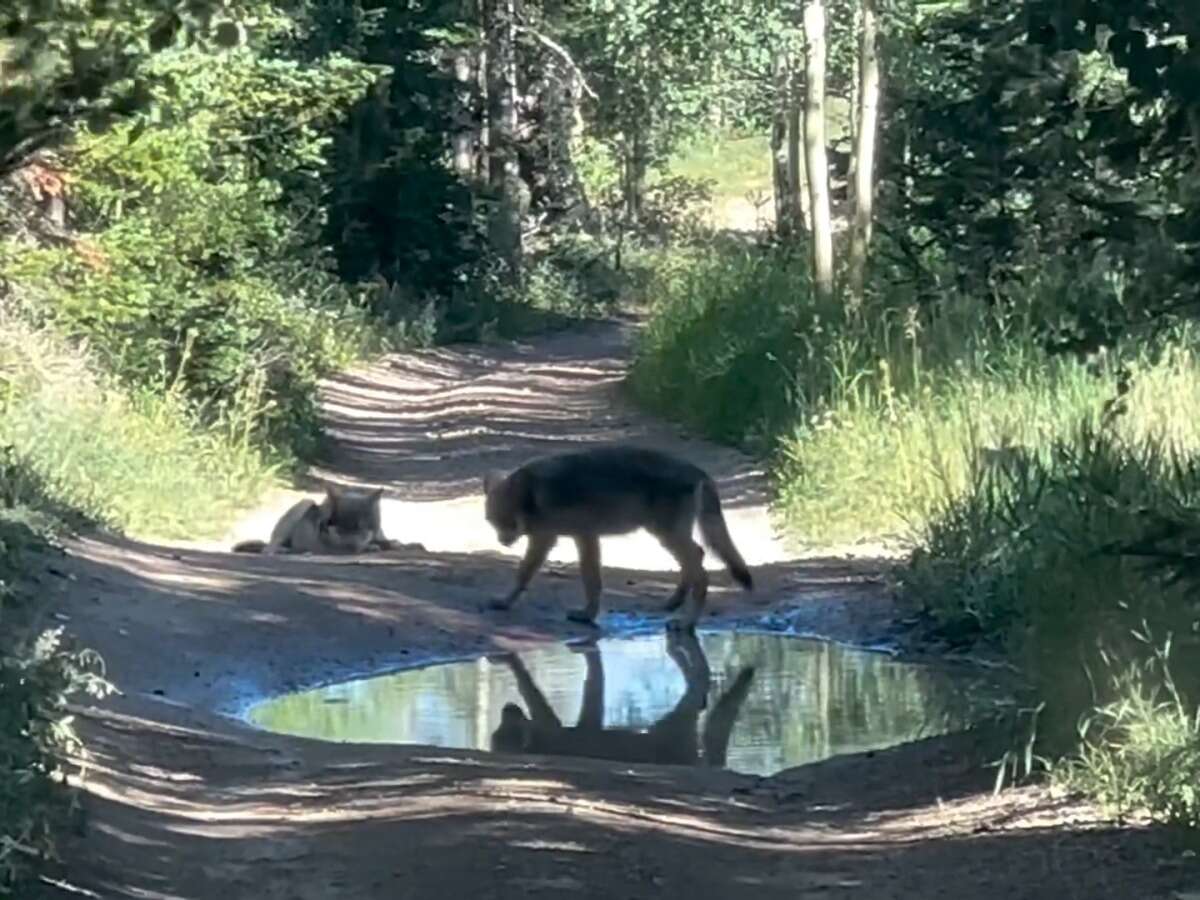Chronic Wasting Disease (CWD) Detected In Jackson Hole Elk Feedground

Table of Contents
Understanding Chronic Wasting Disease (CWD) in Elk
What is Chronic Wasting Disease?
Chronic Wasting Disease (CWD) is a fatal, transmissible spongiform encephalopathy (TSE) affecting cervids—members of the deer family, including elk, deer, and moose. Unlike other infectious diseases, CWD is caused by misfolded prion proteins. These abnormal proteins accumulate in the brain, causing irreversible damage, leading to the characteristic spongy appearance of the brain tissue. This ultimately results in the debilitating and fatal neurological dysfunction that defines the disease.
- Mechanism: The misfolded prions trigger a chain reaction, causing normal prion proteins to misfold as well. This exponential process leads to the progressive destruction of brain tissue.
- Symptoms: CWD manifests gradually. Infected animals typically exhibit progressive weight loss, despite maintaining a healthy appetite. Behavioral changes, such as listlessness, drooling, and loss of coordination, are also common. Sadly, there is currently no known treatment or cure for CWD.
Transmission of CWD
CWD transmission primarily occurs through direct contact with infected bodily fluids, such as saliva, urine, and feces. However, indirect transmission is also possible through contact with contaminated environments. This includes soil, vegetation, and even water sources where prions can persist for extended periods.
- Direct Contact: Direct contact, particularly aggressive interactions between animals, is a significant route of transmission.
- Indirect Contact: Prions are remarkably resilient and can remain infectious in the environment for years, posing a considerable risk even after an infected animal is gone.
- Feedgrounds and CWD Spread: The use of artificial feedgrounds, such as the one in Jackson Hole, increases the risk of CWD transmission by concentrating susceptible animals in close proximity, facilitating the spread of the disease.
- Environmental Persistence of Prions: The exceptional durability of prions in the environment makes effective decontamination challenging, posing a long-term threat to wildlife.
Implications of CWD Detection in Jackson Hole Elk Feedground
Impact on the Elk Herd
The detection of CWD in the Jackson Hole elk feedground carries grave implications for the elk population. The concentrated nature of the feedground significantly increases the risk of rapid disease spread within the herd.
- Rapid Spread: The close proximity of elk at the feedground provides ideal conditions for the rapid transmission of CWD.
- Transmission to other Wild Elk: Infected elk can easily transmit the disease to other wild elk populations through contact or environmental contamination.
- Long-Term Effects: CWD can severely impact the long-term health and genetic diversity of the elk herd, potentially leading to significant population declines.
- Management Strategies: Wildlife agencies may need to implement disease management strategies, including culling infected animals, to control the outbreak.
Threats to the Ecosystem
The consequences of a CWD outbreak extend beyond the elk herd itself, posing risks to the entire Jackson Hole ecosystem.
- Impact on Predators: Predators that rely on elk for sustenance, such as wolves and bears, could be indirectly affected by a decline in the elk population.
- Transmission to Other Cervids: CWD can also affect other cervid species in the area, further disrupting the delicate balance of the ecosystem.
- Economic Consequences: The outbreak could have severe economic repercussions, impacting hunting licenses, tourism revenue generated from wildlife viewing, and the overall economy of the region.
Response and Management Strategies
Current Actions by Wildlife Agencies
Wildlife agencies are actively responding to the CWD detection in Jackson Hole. Their efforts involve a multi-pronged approach.
- Monitoring and Surveillance: Intensified monitoring and surveillance programs are underway to track the spread of CWD within and around the feedground.
- Testing Harvested Elk: Testing of harvested elk provides crucial data to assess the prevalence of CWD and inform management strategies.
- Culling Infected Animals: Culling of infected animals might be considered as a means to reduce the spread of the disease.
- Regulations and Hunting Restrictions: Temporary or permanent hunting restrictions in affected areas might be implemented to manage the spread of CWD.
The Role of Public Awareness and Prevention
Public awareness and cooperation are critical for minimizing the spread of CWD.
- Proper Disposal of Remains: Hunters and the public should adhere strictly to guidelines regarding the proper disposal of hunting remains to prevent environmental contamination.
- Avoid Contact: Avoid direct contact with potentially infected animals. Always maintain a safe distance.
- Support Research: Supporting research into CWD prevention and control methods is crucial for developing effective long-term strategies.
Protecting Jackson Hole’s Elk from Chronic Wasting Disease
The detection of CWD in the Jackson Hole elk feedground presents a serious threat to the elk population and the broader ecosystem. Swift and decisive action is crucial to contain the spread of this devastating disease. This requires a collaborative effort among wildlife agencies, researchers, and the public. We must all work together to mitigate the impact of CWD. Stay informed about CWD, follow guidelines for safe wildlife handling, and support research into Chronic Wasting Disease prevention and management in Jackson Hole and beyond. Learn more about Chronic Wasting Disease and how you can help protect our wildlife.

Featured Posts
-
 The Manhattan Forgotten Foods Festival A Taste Of The Unusual
May 22, 2025
The Manhattan Forgotten Foods Festival A Taste Of The Unusual
May 22, 2025 -
 Core Weave Crwv A Contrarian View From Jim Cramer On Ai Infrastructure
May 22, 2025
Core Weave Crwv A Contrarian View From Jim Cramer On Ai Infrastructure
May 22, 2025 -
 Blake Lively Allegedly Blackmailed Taylor Swift Details Of The Leaked Text Controversy
May 22, 2025
Blake Lively Allegedly Blackmailed Taylor Swift Details Of The Leaked Text Controversy
May 22, 2025 -
 Second Gray Wolf From Colorado Dies After Relocation To Wyoming
May 22, 2025
Second Gray Wolf From Colorado Dies After Relocation To Wyoming
May 22, 2025 -
 Boe Rate Cut Probabilities Fall Following Uk Inflation Figures Pound Gains
May 22, 2025
Boe Rate Cut Probabilities Fall Following Uk Inflation Figures Pound Gains
May 22, 2025
Latest Posts
-
 Route 15 On Ramp Closure Following Accident
May 22, 2025
Route 15 On Ramp Closure Following Accident
May 22, 2025 -
 Recent Drop In Virginia Gas Prices Gas Buddy Data Analysis
May 22, 2025
Recent Drop In Virginia Gas Prices Gas Buddy Data Analysis
May 22, 2025 -
 Lower Gas Prices In Virginia Gas Buddys Latest Report
May 22, 2025
Lower Gas Prices In Virginia Gas Buddys Latest Report
May 22, 2025 -
 Gas Buddy Update Average Gasoline Prices Fall In Virginia
May 22, 2025
Gas Buddy Update Average Gasoline Prices Fall In Virginia
May 22, 2025 -
 Philadelphia Market Sees Consistent Gas Price Increase 6 Cents Average
May 22, 2025
Philadelphia Market Sees Consistent Gas Price Increase 6 Cents Average
May 22, 2025
